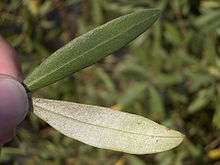Olive leaf

Olive leaf is the leaf of the olive tree (Olea europaea). Although olive oil is well known for its flavor and possible health benefits, the leaf and its extracts remain under preliminary research with unknown effects on human health.
Leaf characteristics
The silvery green leaves are oblong, measuring 4–10 centimetres (1.6–3.9 inches) long and 1–3 centimetres (0.39–1.18 inches) wide. When consumed, leaves have an astringent bitter taste.
Active compounds
Olive phenolics are much more concentrated in the leaves compared with olive fruit or olive oil: 1450 mg total phenolics/100 g fresh leaf vs. 110 mg/100 g fruit and 23 mg/100 ml extra virgin olive oil.[1][2] The primary active compounds in unprocessed olive leaf are oleuropein and hydroxytyrosol, as well as polyphenols and flavonoids, including luteolin, rutin, caffeic acid, catechin and apigenin.[3] Elenolic acid is a component of olive oil and olive leaf extract. It can be considered as a marker for maturation of olives. Oleuropein, together with other closely related compounds such as 10-hydroxyoleuropein, ligstroside and 10-hydroxyligstroside, are tyrosol esters of elenolic acid.[2] The phenolic composition of olive leaf extract varies according to plant variety, harvesting season and method, leaf maturity, storage conditions and extraction method.
Historical uses
Historically the benefits of olive leaves have been used in traditional medicine practices[2] as folk remedies for the treatment of various illnesses.[4] However, scientific evidence for health effects of using olive leaf extract has been deemed insufficient by the European Food Safety Authority to prove any cause-and-effect relationship.[5]
Research
Antioxidant
Plants in the Mediterranean have developed high levels of polyphenols as a protection mechanism against environmental stressors.[6] Some of these compounds display antioxidant properties in vitro.[2][7]
References
- ↑ Lockyer S, Rowland I, Spencer JP, Yaqoob P, Stonehouse W (2017). "Impact of phenolic-rich olive leaf extract on blood pressure, plasma lipids and inflammatory markers: a randomised controlled trial". Eur J Nutr. 56 (4): 1421–1432. doi:10.1007/s00394-016-1188-y. PMC 5486627. PMID 26951205.
- 1 2 3 4 Barbaro, B; Toietta, G; Maggio, R; Arciello, M; Tarocchi, M; Galli, A; Balsano, C (2014). "Effects of the Olive-Derived Polyphenol Oleuropein on Human Health". International Journal of Molecular Sciences. 15 (10): 18508–18524. doi:10.3390/ijms151018508. PMC 4227229. PMID 25318054.
- ↑ Herrero, M; Temirzoda, T. N.; Segura-Carretero, A; Quirantes, R; Plaza, M; Ibañez, E (2011). "New possibilities for the valorization of olive oil by-products". Journal of Chromatography A. 1218 (42): 7511–20. doi:10.1016/j.chroma.2011.04.053. PMID 21600577.
- ↑ Pinelli P., Galardi C., Mulinacci N., Vincieri F., Tattini , Romani A (2000). "Quali-quantitative analysis and antioxidant activity of different polyphenolic extracts from Olea europea L. leaves". Journal of Commodity Science. 39 (2): 71–83.
- ↑ EFSA Panel on Dietetic Products, Nutrition and Allergies (2014). "Scientific Opinion on the substantiation of a health claim related to olive (Olea europaea L.) leaf water extract and increase in glucose tolerance pursuant to Article 13(5) of Regulation (EC) No 1924/2006". EFSA Journal. 12 (5). doi:10.2903/j.efsa.2014.3655.
- ↑ Vivioli F., Bellomo G., Galli C. (1998). "Free radical-scavenging properties of olive oil polyphenols". Biochemical and Biophysical Research Communications. 247: 60–64. doi:10.1006/bbrc.1998.8735.
- ↑ Wojcikowksi K., Stevenson L., Leach D., Wohlmuth H., Gobe G. (2007). "Antioxidant capacity of 55 medicinal herbs traditionally used to treat the urinary system: A comparison using a sequential three-solvent extraction process". The Journal of Alternative and Complementary Medicine. 12 (1): 103–109.